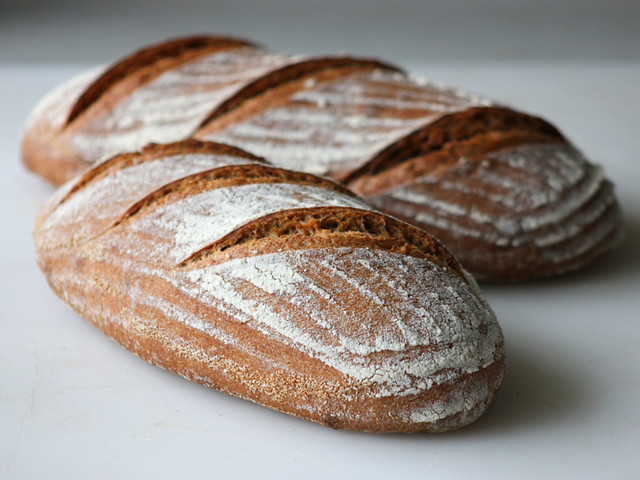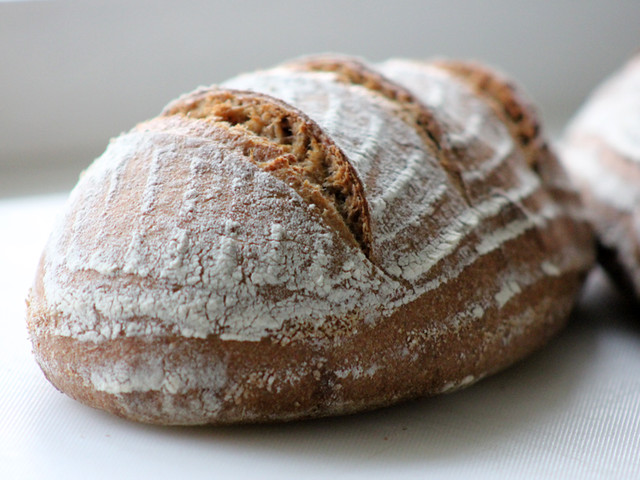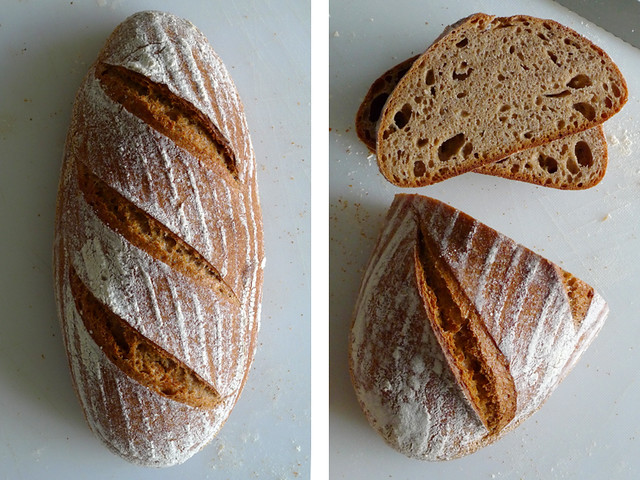
Micropost – Spelt experiment II (75% Spelt)
Formula
Overview | Weight | % |
Total dough weight | 1600g |
|
Total flour | 969g | 100% |
Total water | 630g | 65% |
Total salt | 19g | 2% |
Prefermented flour | 242g | 25% |
|
|
|
Starter build – 8 hrs 27°C |
|
|
Rye starter @ 100% hydration | 50g | 20% |
Sifted Wheat | 242g | 100% |
Water | 121g | 50% |
|
|
|
Final dough 25°C |
|
|
Starter | 363g | 50% |
Sifted fresh milled Spelt | 727g | 100% |
Water | 510g | 70% |
Salt | 19g | 2% |
Method
- Autolyse 45 mins
- Knead 5-10 mins
- Bulk ferment 1.5 hours with stretch and fold at 45 mins
- Preshape and bench rest for 15 mins
- Shape and proof for 45 mins
- Bake in steamed oven for 10 mins at 250°C then 30 mins at 200°C
I have come to the realisation that I don’t enjoy working with large proportions of spelt flour in dough. The flavour of the bread was ok, but considering it contained 75% sifted spelt flour I found it rather bland, left me wanting more from it. As the temperatures continue to climb here (yesterday was a hot and humid 32°C) I am finding the spelt breads ferment way too fast for my liking even when using cooler water.
I think I will stick with wheat breads and smaller proportions of spelt (30% is a favourite of mine)
… also looks like a busy weekend of baking coming up … and with Christmas fast approaching it seems just about all of our upcoming weekends have social events hopefully requiring bread :)
Cheers, Phil






Comments
It's a tricky flour indeed, but I sometimes use white spelt with whole..... When I was in Switzerland I met a spelt miller, even drank spelt beer.... Go for 100% spelt.
By the way, you got me on making a desem starter...going to attempt a play on the fig loaf with anise, but instead with my favorite combo, currants and anise, goes great with blue cheese!
Ta!
Jeremy
www.stirthepots.com
Cheers Jeremy ... I reckon if I go for 100% spelt, i'll use a tin.
From what I have heard, spelt can be a bit of a pain to process before milling compared to wheat.
Have fun with the desem starter. I really enjoy using it. It's hard to describe, but after a week in the fridge the desem ball and fresh flour it was sitting in have the most amazing sweet aroma...it fills the kitchen when I take the lid off the jar. I had never noticed it before until I started milling my own flour.
I have never used currants with anise ... sounds great. I also make a currant and cardamon loaf which uses some orange juice to soak the currants and orange rind in the dough as well.
Cheers,
Phil
I very often add small amount of spelt to flour mix for many of my bread but never attempted to add more than 20%.....because I'm a chicken! :p So I fully respect anyone who can bake spelt-rich bread, and making it with rye levain wins even more respect.
Sorry to hear you didn't like the flavour very much after all those effort, but still your loaves look beautiful, as always.
This is from someone who've never milled her own flour, so please ignore if I'm wrong, but.......Is freshly-milled flour supposed to taste best? I seem to remember having read somewhere that some flour needs to be left for sometime (days? weeks?...can't remember) to 'mature' to develop the flavour. Just wondering that could've been the reason why the flavour wasn't to your expectation??? .......though I must admit I wasn't too impressed by the flavour of 100% spelt bread I had some years ago.....
P. S. - I shouldn't say this, but it's rather comforting to see even a very talented baker like you do make a bread you don't like sometimes. :p Yesterday I made Royal Crown Tortano for the first time....and I can tell you that was the first time ever in my long baking life that I really wanted to throw away what I baked. ...... I love Tortano. It's one of my favourite. I saw Freerk made a beautiful one from the same recipe I used (from Maggie Glezer). So it's me....entirely my fault......
Your post lightened up my feeling a bit. Thanks for that, too! :p
Glad I could lighten your day Lumos,
I think i've mentioned before that I like the idea of spelt bread more than the bread itself :)
I'm not unhappy with the bread, just surprised and disappointed with how mild and flat the flavour was. I had some tonight with dinner and the flavour has improved a little, but I still find it bland. I have heard people mention that spelt bran can taste bitter so I endeavoured to sift the majority out to get a pure flavour...oh well
The taste and aroma of fresh milled flour (especially wheat) is amazingly different from bagged flour bought from a shop. It tastes sweet when first milled and the smell is so rich.
Still seems to be a lot of debate about aging flour. I believe it is necessary for white flour but for wholemeal or lightly sifted I think any benefits gained from aging (gluten development and the like) would be outweighed by the winning flavour. The most I let the fresh flour sit is 12 hours and that is to give the family a sleep in so I am not milling first thing in the morning :) and I have had no issues with the way the dough behaves.
So sorry to hear about your Tortano crown ... I guess its good for us to have roadbumps along the way ... helps us improve and learn :)
Anytime you need cheering up I have plenty of baking disaster stories to tell ... (I used to rent a place where the oven would turn off intermittently ... drove me completely insane)
Cheers, Phil
These spelt breads are a thing of beauty. I just bought a bag of fresh milled spelt and I'm hoping you can recommend a recipe with good flavor. I have added a small amount in the past to various recipes and noticed a change in the flavor and the feel of the dough. Any ideas?
Eric
Hi Eric,
No specific formulas that I keep going back to sorry ... Is it white spelt or wholemeal? I have used the spelt formula in the Bourke Street Bakery book with store bought white spelt and had some ok results, and a few years ago I used to make the spelt bread form Richard Bertinets "Crust" book ... it uses a spelt poolish. If it is wholegrain flour I would be inclined to add it to at around the 20-30% in campange style loaf ... I really like it in this context and the bran has nice colouring to it.
All the best with it...
Phil
...from Odinraider's blog. Last time I used whole spelt in the levain, but 'chickened-out' for the main dough and used white spelt, as the type wasn't specified. [Total about 30% spelt, with WW and coarse rye, plus some strong, white wheat flour...how could it not be good?]
http://www.thefreshloaf.com/node/19717/something-new
It's very forgiving with timing and small variations, while the aroma and taste are great! You might've tried it before...if not, I'd say it's worthwhile giving it a go.
Best,
Adam
given the high spelt content. Oh no. Scratch the qualification. Pretty remarkable looking loaves period. -Varda
Thanks Varda,
The spelt is keeping me on my toes...
cheers, Phil
Hi Phil,
A couple of thoughts come to mind. Can you apply cooler proving for your spelt bread? I understand your frustrastion with 32*C ambient temp, but note from your comment on my thread that you are familiar with adapting proving regimes to bake multiple loaves from the same dough batch?
Yes, bitterness in Spelt flour comes up for frequent discussion. A question that never did get fully answered, was how fresh the flour was when bitterness was identified? So, turn that on its head, in your situation. If the flour is freshly milled, then maybe you won't have the bitterness problems.
Fantastic photography, and the bread looks lovely. I do, however appreciate all the difficulties you note about working with large proportion of spelt in a sourdough context.
Very best wishes
Andy
Hi Andy,
Its the humidity that we have been having lately with the heat that is really throwing me a curve ball ... hard to escape it. I much prefer a dry heat. I even built a preferment today that sat in the basement in a plastic container with some ice bricks close by ... The fridge also gets quite a workout for proofing as well. I am a bit cautious with spelt as I have had it run away on me before so I decided not to retard this time + the oven was required for dinner so had to get in first :)
There is no bitterness in the flavour at all. We had some tonight (2 days after baking) and he flavour is actually not too bad now but the mouth feel is starting to dry up which is something I relate to spelt breads.
Had a thought that maybe next time I should use spelt in the preferment and use the 25 %wheat in the final dough for some decent gluten development instead of having it eaten up by yeasties and bacterias...
Might try the next one in tins too...
Cheers, Phil
I've never had a bitter spelt loaf using a rye starter. I do have to be careful not to let spelt proof too long.
I got the pork roast drippings to go with your lovely bread. Finely sliced onions and salt too!
Surely, not everyone likes spelt. As so often that is a matter of personal taste. I've been fascinated by spelt for a while and didn't accept that "spelt is impossible" to bake with. Baking a spelt bread in a tin is not challenge. The real challenge is to make a free standing bread. It took a lot of work. A lot. But, as you can see from the attached photo, it worked out after many experiments and a lot of lab work. The bread on the picture is made with a 100% organic spelt mixture of wholegrain and light spelt flours. The preferment (biga) is also 100% spelt. No other flours, no bakers yeast, no oils, no sugars or "improvers". Pure spelt, clear water and salt! So, to those of you who believe it is impossible. Get back on the horse. Happy baking.
IMG_0217.jpeg